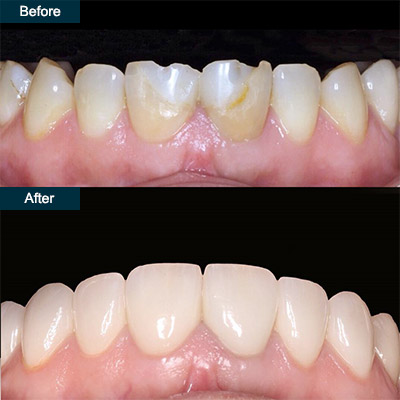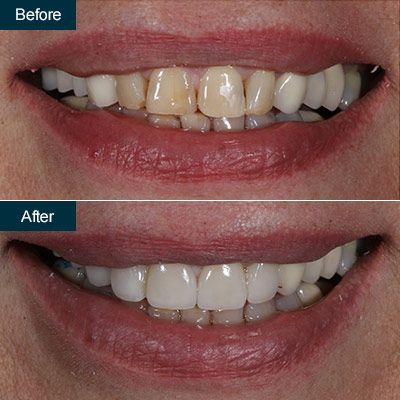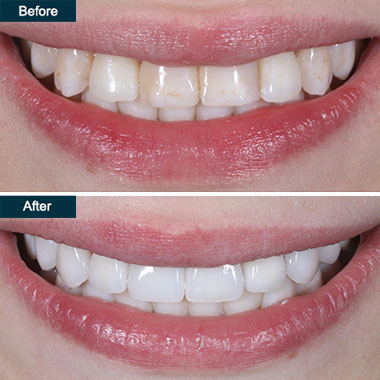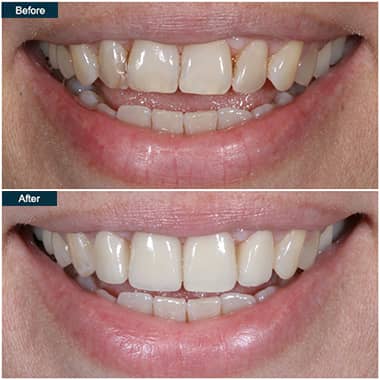Table of contents
For a limited time, we are offering veneers starting from as low as $899 per tooth. While alternatives to veneers’ teeth may be cheaper than porcelain veneers, their cost is worth the investment. You’ll love the way you look and appreciate the added protection your natural teeth receive. Visit your local dental center in Brooklyn to receive the most efficient, functional, and highly esthetic veneer teeth.

Teeth can become discolored over time. Along with discoloration, you may have misshapen, worn-down or broken teeth — or a host of other unsightly conditions. While these can occasionally affect eating and speaking, most people choose dental veneers as a cosmetic dentistry procedure to raise their confidence in their smile and appearance.
Veneers on teeth are handcrafted by the best-rated dentist, Dr. Alex Khabensky to fit your individual teeth. Dental veneers are made from thin shells of porcelain that are designed to fit perfectly over the front surface of a tooth. The surface of the tooth especially prepared, usually by removing a minimal amount of tooth enamel, which ensures a natural and comfortable appearance. Dental veneers are bonded onto the tooth surfaces with special cement.
Snap-on veneers teeth don’t discolor over time and resist fracturing and chipping. We require multiple visits to measure your mouth, prep your teeth and sculpt your dental veneers.

Cosmetic dental problems can occasionally affect eating and speaking, but mostly they affect how you feel about your appearance and smile. You can consider a veneer if the tooth in question is generally healthy and strong and does not have any large fillings or other signs of damage.
Veneers are wonderful for hiding small cracks and chips in teeth. They can cover severely stained teeth, which cannot be whitened, for example, if they are stained internally. You can also use veneers to improve the appearance of teeth that are too small, not quite the right shape, or which are worn down.
You may want to consider porcelain veneers for correcting any of the following problems:
Your dentist may even suggest using porcelain veneers to protect damaged teeth, reducing the need for more extensive treatments later.
You are a good candidate for porcelain veneers if:
The treatment is minimally invasive, but your teeth need to be strong and healthy, and they shouldn’t have very large fillings, and their overall structure should be largely intact.
Teeth that are more badly damaged by trauma or which have large fillings or significant tooth decay might benefit from different dental restorations, for example, porcelain crowns that cover the entire tooth.
Porcelain crowns provide far more protection for a severely damaged tooth, restoring its strength, structure, size, and appearance.
To find out if this is a viable option, you should schedule an appointment with your dentist. They can assess the overall condition of your teeth and talk to you about your treatment goals and desires before recommending the best options for giving you the smile of your dreams. If cosmetic veneers are part of your treatment plan, the procedure is very simple.
Some people only need to have a few veneers, as their teeth are otherwise quite nicely shaped. Others will opt for a more comprehensive treatment, where they are fitted with multiple veneers covering most or all the teeth they show when smiling or talking. Your choice depends on your aims for treatment, and often veneers are used as part of a more comprehensive smile makeover.
There are several different types of veneers available, depending on your individual needs and dental cost considerations. These range from permanent solutions to temporary or removable considerations:


No matter which type of veneers on teeth you select, permanent or snap-on veneers, your family dentist performs similar steps to place them:

Once Dr. Khabensky, DDS has confirmed you are suitable for porcelain veneers, he can begin to plan your treatment. To do this, he may take:
Quite often, our dentists will use smile design technology to digitally manipulate images of your teeth, showing how they will look once treatment is completed. It’s a great idea because you can become involved with designing your new smile and the design can be altered until you are entirely happy with the result.
Prepared for the veneers. Usually, your local dentist or Alex Khabensky DDS reshapes your teeth, removing approximately 0.5 mm of material from the front surfaces, which will be veneered. This is about the same approximate thickness as a porcelain veneer and ensures your new restorations look natural and don’t feel too bulky once they are fitted in the mouth.
Tooth preparation is done using a local anesthetic to numb the tooth fully while it is carefully shaped.
The impression of your mouth. Once your teeth are prepared, your dentist will take a dental impression which is used to custom make your veneers.
Dental laboratory. If your veneers are to be made in a dental laboratory, you will almost certainly need the temporary ones. Sometimes these temporary veneers are made using the digital images created during the smile design process, so you effectively get to trial your new smile. This can be incredibly useful because if there’s something you don’t like about your new teeth, then doctor Khabensky DDS can alter the design.
Sometimes, your dentist doesn’t need to remove any tooth structure. There are certain types of veneers called prepless or prep-free veneers and which are incredibly thin yet strong. However, they are only suitable in specific situations, so it’s best to be guided by your dentist’s advice.
With prepless veneers, you won’t need to wear any temporary veneers as they are fitted directly over your natural teeth. If you wish, you can always reverse treatment later if for some reason you decide you no longer want to have dental veneers. This isn’t possible with conventional veneers where some tooth structure is removed.
Once your new veneers are ready, they are bonded onto your teeth, and you can show off your new smile to everyone. Porcelain veneers are pretty hard-wearing, but it’s important to treat them nicely, and this will help to prolong their life. Make sure you brush your teeth and your veneers at least twice a day and floss around your new all your teeth, including your veneers.
With the proper care, your porcelain veneers could last you for ten years or more. Often prep less or prep free veneers will last even longer although they tend to cost a little more.
Dental bonding is an economical alternative to veneers, using a tooth-colored composite resin that is applied directly to your tooth surfaces. Once hardened, the composite resin is shaped and polished, creating a natural appearance. Dental bonding is the ideal solution if you only have one or two teeth that require treatment and where you prefer a subtle effect. However, composite resin won’t last as long as porcelain, and it can become stained after a few years.
Porcelain crowns cap the entire tooth, so none of its original structure is visible. Because the crown covers the whole tooth, substantial preparation is needed to remove enough structure to make room for the crown. Porcelain crowns can change the color and shape of the tooth, and the latest all-ceramic crowns look fantastic.
Porcelain crowns are used when a tooth is severely damaged. For example, if you have a tooth with significant tooth decay or which is severely chipped or cracked, or if you have a tooth that has received root canal therapy.
These situations usually destroy a significant amount of the original tooth structure, and placing an ordinary filling wouldn’t be sufficient to restore strength and structure to the tooth. Dental crowns can also be useful for people with significant bruxism where they have worn their teeth down by grinding and clenching, or for those who have suffered from significant enamel erosion.
Crowning a tooth restores the missing tooth structure and the tooth appearance, ensuring you can bite and can smile and talk confidently because your teeth will look great.
You might want to consider adult orthodontics such as teeth straightening if you have several teeth out of alignment, as this can be a preferable and more conservative treatment compared with porcelain veneers.
If you were to choose veneers, your dentist would most likely need to remove a substantial part of the tooth structure to create enough room for the veneers and to bring your teeth into line.
Instead of cutting back healthy teeth, these teeth can be brought back into line with modern orthodontic solutions that are often extremely discreet, for example, Invisalign. Although treatment may take a bit longer to complete, you will be left with a healthy, straight smile and teeth that haven’t been heavily modified.
Porcelain veneers don’t ruin your real teeth. Your dentist designs them to fit over your natural teeth, enhancing their appearance. The composite resin used in bonding them to your teeth isn’t harmful to your natural teeth. That’s why getting veneers attached doesn’t hurt or ruin your tooth underneath.
Depending on your choice, the fee for composite resin dental veneers per tooth can be around $650 (done directly in-office). Traditional porcelain veneers (done in a dental laboratory) can cost anywhere between $925 and $2,200 per tooth. Our dental office has a special on high-quality veneers starting from just $899. Give us a call to learn more about financing options and clip-on veneers today! Both of these options will be discussed at your consultation visit. Since our team cares about your goals, you can share your concerns about the cost and discuss alternatives to veneers as well.
Veneers are a more conservative option than other alternatives such as bonding and crowns since less reshaping of your natural teeth is required. Most insurance companies don’t cover veneers, however, so other options may suit your needs better. Since multiple options exist to protect your teeth and enhance your appearance, the best-rated dentist in Brooklyn works to find the method that best helps you achieve your dental needs and goals.
These types of dental treatment can both have a positive effect on your smile and oral hygiene. The main difference between veneers and crowns is the size of the treated area. Veneers protect the front side of your tooth, while the crown envelops the tooth completely.
During the veneer placement process, less of the tooth surface needs to be reshaped. For crown placement, between 60% and 75% of the natural tooth needs to be shaved off.
Read more: What is the Difference Between Crowns and Veneers?
Dental porcelain laminates can solve the aesthetic issues of your smile. They can mask teeth deterioration and yellowing of the enamel. With proper care, dental porcelain laminates can last you many years. Nevertheless, they can’t be restored and need replacement if they chip or crack. Porcelain veneer prices can be higher than the cost of lumineers.
Read more: When to Choose Dental Veneers or Lumineers?
The placement of veneers involves little to no discomfort. The removal of a thin enamel layer is generally a painless process. If you have sensitive teeth, the local anesthetic can be used to avoid uncomfortable sensations. If the procedure was done correctly, your veneers shouldn’t hurt, put pressure on your teeth, or bring any discomfort.
Many studies investigated the longevity of porcelain veneers. The goal was to evaluate the quality, success rate, and survival rate of veneers in a long-term analysis of up to 20 years. According to multiple studies, porcelain veneers have excellent aesthetic properties and long-term results.
Porcelain laminate veneers offer a predictable and successful restoration. Based on a study published on PubMed: “Clinical performance of porcelain laminate veneers for up to 20 years” the estimated survival rate was:
Note: Increased porcelain veneers failure rate was associated with bruxism and nonvital teeth. The discoloration was worse in patients who smoked.
In another study, the success rate of porcelain veneers placed by inexperienced dentists was only 65.52%. That means the third of all the patients had restoration failure such as:
- Color change
- Debonding
- Fracture
Factors that play an important role in patients’ satisfaction are durability, aesthetic outcome, and the cost of the treatment. According to the study “The Success of Dental Veneers According To Preparation Design and Material Type” patients satisfaction with different material types for veneers are:
Do you have any questions about the dental veneers or press on veneers procedure? For more information or to schedule an appointment with the top-rated dentists Alex or Igor Khabensky DDS, call our dental center at: 718-339-8852